Sanma Shioyaki (Grilled Pacific Saury) is a classic Japanese preparation where fish is cooked whole over charcoal until the skin crisps up. The smokiness from the grill adds a level of amazingness to the dish. Enjoy with grated daikon and lemon.

When autumn comes around, I crave fish, mushroom, and chestnut. These are just a few of the seasonal ingredients that the Japanese enjoy as the temperature drops and the evening air gets crisp. It’s when I eagerly anticipate one of my favorite autumn fish called sanma, or Pacific saury.
Luckily for me, my husband mastered charcoal grilling over the summer (see our BBQ recipes). So, we actually charcoal-grilled this fish for the first time instead of oven-broiling it as in my other sanma recipe. The smokiness from the charcoal added another layer of flavor and it was amazing! That’s why I’m so excited to share this Sanma Shioyaki recipe with you today.
Table of Contents
What is Sanma Shioyaki?
Sanma (秋刀魚) is the Japanese name for Pacific saury, a type of migratory ocean fish that matures in the fall. It’s a well-known seasonal fish that represent autumn in Japanese cuisine. It literary means “autumn swordfish” in reference to sanma’s season and its body shape resembling a sword. It’s also called mackerel pike.
Sanma is often salted and grilled in a Japanese cooking preparation we call shioyaki (塩焼き), where shio means salt and yaki means grilled. Since fish in Japan like sashimi is generally very fresh, we use a simple cooking method to enjoy the fish’s freshness itself. You may recognize this word from similar dishes like saba shioyaki (salt-grilled mackerel).
Ingredients You’ll Need
Make sure to use the freshest fish that you can find. You can purchase sanma in most Japanese supermarkets during the autumn season.
- whole Pacific saury (sanma)
- kosher salt – I use Diamond Crystal brand
- daikon radish – peeled and grated; optional
- wedge lemon – optional; or use sudachi if you can find it!
- soy sauce – optional
How To Make Sanma Shioyaki
Sanma is usually grilled whole with the head and guts intact. Here’s how to prepare it:
- Rinse the whole sanma under cold running water and pat dry with a paper towel.
- Sprinkle kosher salt on both sides of the fish. Set aside for 10 minutes.
- Score the fish lengthwise next to the gills with a sharp knife on both sides.
- Grill the fish. Place the sanma on the grill, presentation side down. Grill for 8–10 minutes, then flip the fish to grill the other side. Transfer to individual plates.
4 Cooking Tips for Sanma Shioyaki
- Salt the fish for just 10 minutes. This precise length of time lets the fish absorb the salt flavor, removes any unpleasant odor, and dehydrates the flesh just enough without compromising its texture.
- Score the fish to keep the skin from bursting during grilling. To know where to score, you can simply follow the line that runs along the fish’s body.
- Grill over strong heat but no flame. If the charcoal gets too hot, sprinkle some water on it so the fish doesn’t catch fire and burn.
- When the sanma’s eye turns white, it’s done cooking.
How To Eat Sanma Shioyaki
We usually serve sanma with grated daikon radish on the side and a wedge of lemon (in Japan, we usually use sudachi).
- Pour a dash of soy sauce over the grated daikon.
- Squeeze lemon/sudachi all over the fish.
- Place the daikon (now soaked in soy sauce) on top of the fish.
- Dissect the fish with your chopsticks by spreading it from the center where it’s scored.
- Pick up some fish and a bit of daikon together for the perfect bite!
The guts (mainly stomach and intestines) are highly nutritious but very bitter, so we often skip eating this part. Some Japanese actually eat it!
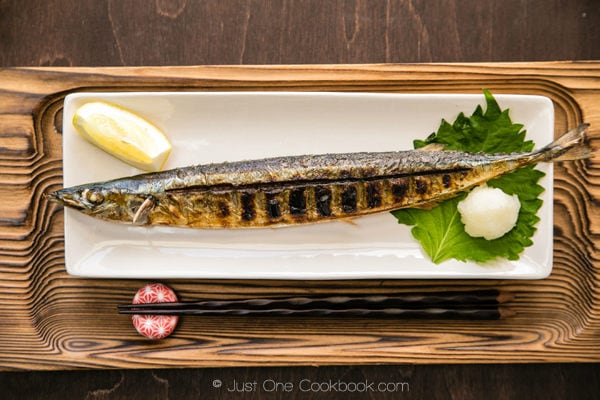
What To Serve with Sanma Shioyaki
I love fall, and this Sanma Shioyaki is a truly delicious way to enjoy sanma season! Here are some recipes for dishes that I suggest serving with this fish:
- Rice: Japanese Steamed White Rice, Takokomi Gohan (mixed rice), Sweet Potato Rice, Mushroom Rice
- Soup: Homemade Miso Soup, Japanese Clear Soup (Osumashi), Tonjiru (pork and vegetable miso soup)
- Side Dishes: Simmered Kabocha, Kimpira Gobo (braised burdock root), Spinach with Sesame Sauce (Gomaae), Nishime/Chikuzenni
- Pickles: Everyday Pickles (Asazuke), Tsukemono (Soy Sauce Pickling), Cabbage Pickles
Wish to learn more about Japanese cooking? Sign up for our free newsletter to receive cooking tips & recipe updates! And stay in touch with me on Facebook, Pinterest, YouTube, and Instagram.
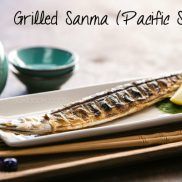
Sanma Shioyaki (Grilled Pacific Saury)
Ingredients
- 2 whole Pacific saury (sanma)
- Diamond Crystal kosher salt
For Serving
- 2 inches daikon radish (peeled and grated; optional)
- 1 lemon (cut into wedges; optional)
- soy sauce (optional)
Instructions
- Gather all the ingredients. To grill the fish under the broiler in the oven, see my recipe for Salt-Grilled Pacific Saury.
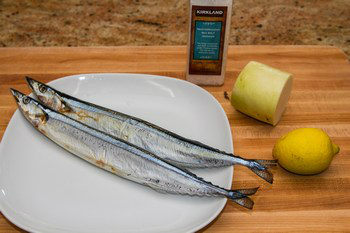
- Rinse 2 whole Pacific saury (sanma) under cold running water and pat dry. Sprinkle Diamond Crystal kosher salt on both sides of the fish. Set aside for 10 minutes. This will dehydrate the fish.
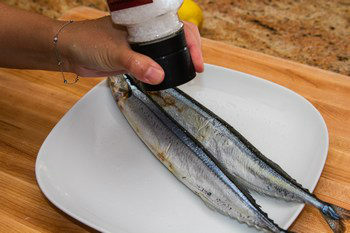
- To keep the fish skin from bursting during grilling, insert a sharp knife next to the gills and score lengthwise (see below).
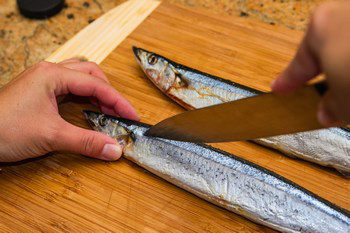
- The fish has a line running across its body where you need to score so just follow that line.
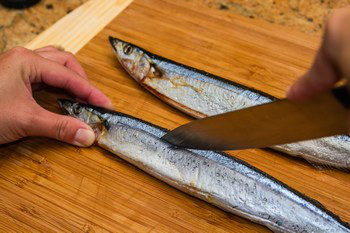
- Repeat on the other side.
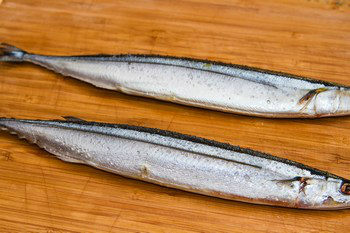
To Grill
- Start the grill.
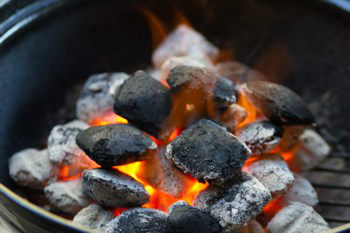
- Place the sanma on the grill, presentation side down (the side that is going to be showing when you serve). Grill for about 8–10 minutes on each side.
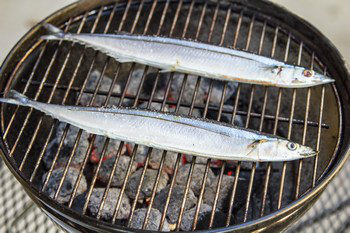
- Grill over strong heat but no flame. When the charcoal gets too hot and the fish is about to catch fire, sprinkle some water on the flame so the fish doesn’t burn.
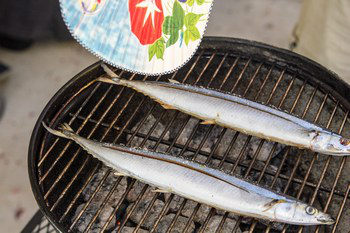
- After 8–10 minutes, the eye will turn white; that’s the sign that it’s cooked. Flip the fish carefully just once.
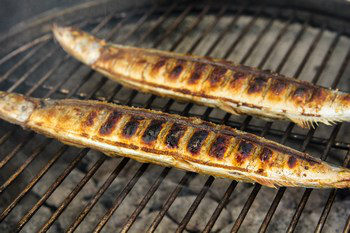
- Grill the other side for 8–10 minutes. Remove and serve on individual plates.
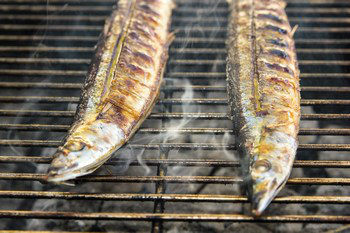
- Right before you serve, grate 2 inches daikon radish. Squeeze out some of the liquid gently and serve alongside wedges cut from 1 lemon. Pour soy sauce over the grated daikon and place it on top of the grilled fish to eat together.
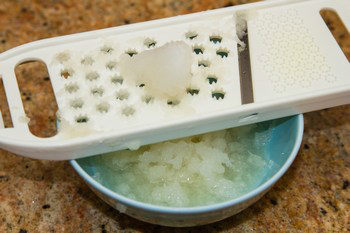
To Store
- You can keep the leftovers in an airtight container and store in the refrigerator for a day or in the freezer for a week.
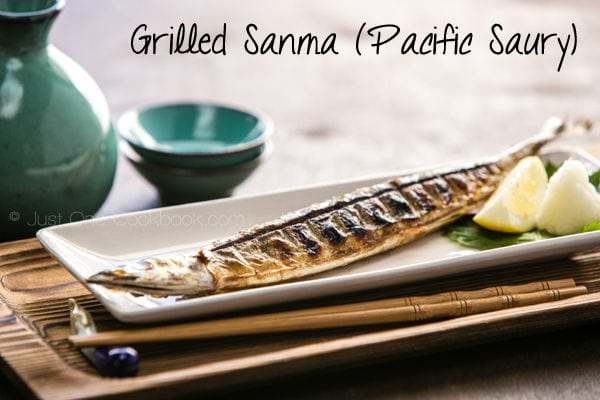
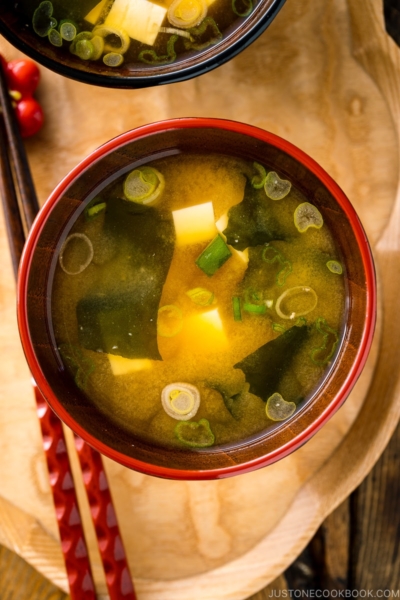
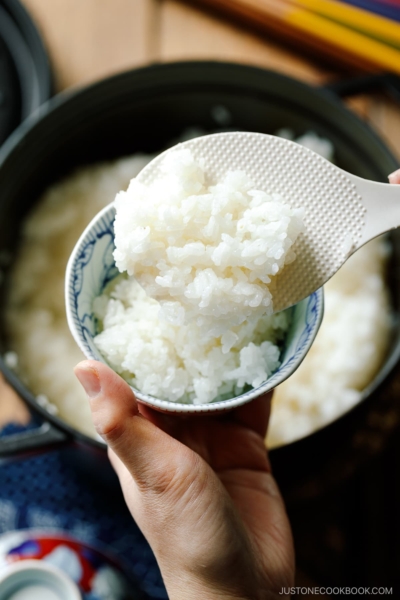
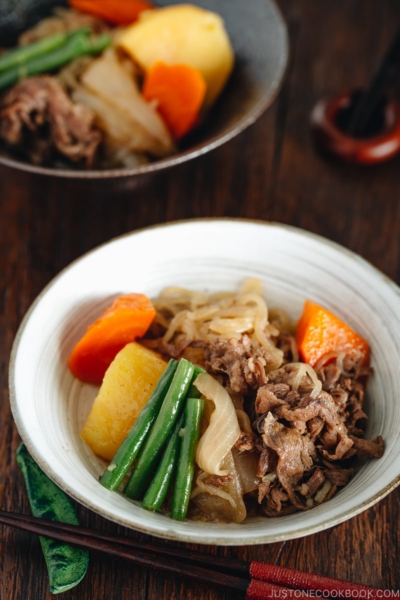
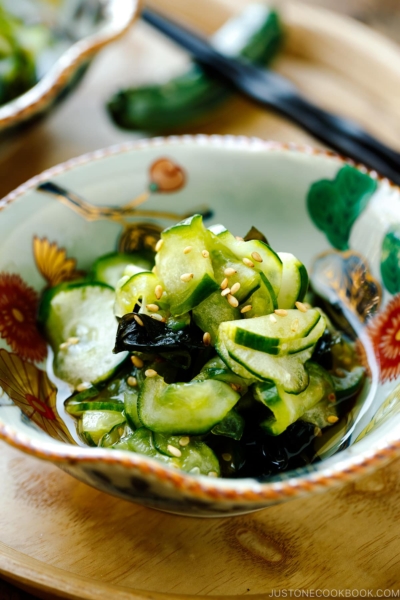




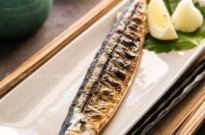
Reviving this. I am still amazed on how the Japanese disect the bones using their chopsticks!
Hi Onio! Hahahahhaha! Yes, all we need is a pair of chopsticks. 😉 Thank you for making me smile!
Hello Nami,
Thank you so much for all your recipes. They inspire me a lot !
I have one question concerning grilled fish ! For some recipe you use sake and salt, but for some recipe, you only use salt. Could you precise when if we need sake according to the fish ? Or you can do both wah for every kind of fish ?
Thank you.
Hi Suzanne! I’m happy to hear my recipes inspire you. 🙂 You have a great question!
In general, salt is used to remove the fishy smell. Usually use 2% of fish’s weight (200g fish, 4 g salt). Salt draw the moisture from the fish and wipe off the moisture with paper towel.
Now sake can remove/mask the odor too, but it also brings out the umami of the ingredients and make the fish flesh “plump” (that’s how we express in Japanese).
So… use the salt for sure, but sake can be up to you. 🙂
I like to put some soy sauce on the fish instead of salt. My mother did it that way. This is a good tasting fish and reminds me of growing up and visiting my relatives in Japan!
Wanted to add… just bought some from my local market. Sanma from Japan! Cleaned them and my hands smell like fish! I don’t mind. So delicious soon!
Hi Chieko! We usually sprinkle salt to cook, but when we eat, we pour soy sauce over the grated daikon and eat it together with sanma. Sanma in season is so delicious! I need to get some too! 🙂
p.s. sorry about my late response!
wo bekomme ich den fisch (sanma)
wo kann ich diesen fisch käuflich erwerben
If Google translates correctly, you are asking where we can get Sanma. You can find it in Japanese/Asian supermarkets, but it’s seasonal fish, so either during fall/winter months or it can be in freezer section. Hope you can find it. 🙂
Thank you for the simple instructions! I’ve always wanted to grill sanma at home.
What (veggie) side dishes would you recommend, aside from the daikon?
Hi CM! Thank you for your comment. This is one of the easy recipe and I hope you enjoy sanma at home!
Here are some of my favorites:
https://www.justonecookbook.com/recipes/eggplant-with-sesame-ponzu-sauce/
https://www.justonecookbook.com/recipes/green-bean-shiraae/
https://www.justonecookbook.com/recipes/spinach-with-sesame-sauce/
https://www.justonecookbook.com/recipes/spinach-ohitashi-japanese-spinach-salad-with-bonito-flakes/
Hope that helps!
Hi Nami,
Thanks for sharing another simple recipe. I’ve seen this fish in asian markets and have always wondered how to cook it.
Hi Candice! Sanma season is very short, so I’m going to enjoy this fish as much as I can. 🙂 I think this dish is popular in Asian countries too.